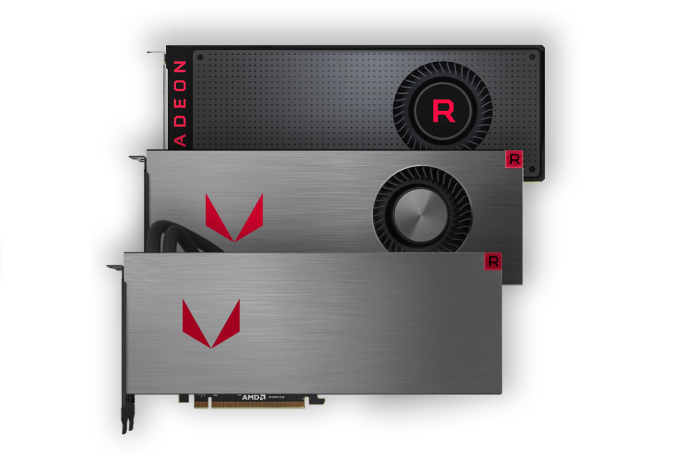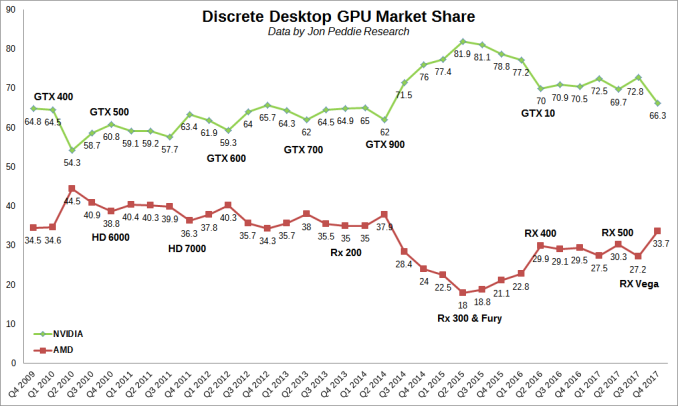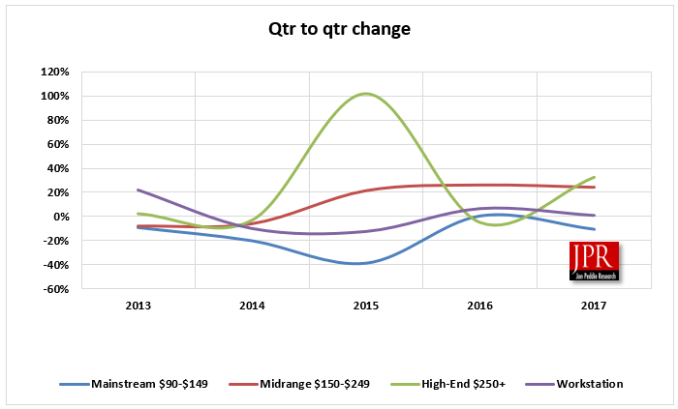Cryptomining Inflated Prices Affect Q4 2017 Discrete Graphics Card Shipments, AMD Climbs to 33.7% Market Share
by Nate Oh on March 1, 2018 9:00 AM EST
This week, Jon Peddie Research (JPR) released their much anticipated quarterly discrete video card sales report for Q4 2017.
Overall, the research firm is reporting a 4.6% decrease in graphics add-in board (AIB) shipments from last quarter. According to JPR, this is in line with their seasonal ten-year Q3-to-Q4 average of -4.4%; and yet despite this, Q4 was hardly a normal quarter in the industry. As many long-time readers are already well aware, Q4 is when GPU cyrptocurrency mining came back with a vengeance, and indeed without mincing words, the report attributed Q4 2017’s figures to a combination of cryptocurrency mining demand inflating average selling prices, as well as seasonality.
Interestingly it's arguably the latter point that's the more salient. While cryptocurrency prices have affected prices, the long ramp-up/ramp-down cycle for beginning-to-end video card production means that the industry can't radically alter volumes inside a single quarter. In other words, GPU manufacturers and their partners have to plan for the quarter in advance, and a typical Q4 plan would involve tapering back on production a bit to match the traditional seasonal demand.
In total, JPR estimates that over three million graphics cards were sold to cryptocurrency miners, adding up to $776 million in sales. Of these sales, AMD benefitted the most - as one might expect from their early performance advantage in cryptocurrency mining performance. As a result, AMD’s discrete desktop graphics market share is up 6.5 percentage points from Q3 2017, increasing to 33.7%, while NVIDIA’s stands at 66.3%.
| Discrete Desktop GPU Market Share Data by Jon Peddie Research |
|||||
| Q4'2017 | Q3'2017 | Q4'2016 | |||
| AMD | 33.7% | 27.2% | 29.5% | ||
| NVIDIA | 66.3% | 72.8% | 70.5% | ||
In the public report, it was not specified how much of the market share change was attributable to disproportionate mining sales. Nevertheless, this brings AMD’s share to the highest it has been since Q2 2014. Including all desktop and notebook GPUs, market share remains fairly similar to last quarter, with AMD picking up 1.2%, Intel down 0.4%, and NVIDIA down 0.9%. AMD’s overall GPU shipments were up 8.08% from last quarter, while Intel’s total shipments were down 1.98% and NVIDIA’s down 6%.
| Total GPU Market Share Data by Jon Peddie Research |
|||||
| Q4'2017 | Q3'2017 | Q4'2016 | |||
| AMD | 14.2% | 13.0% | 14.4% | ||
| Intel | 67.4% | 67.8% | 68.1% | ||
| NVIDIA | 18.4% | 19.3% | 17.5% | ||
| Change in GPU Unit Shipments by Segment Data by Jon Peddie Research |
||||
| Quarterly Change | Annual Change | |||
| Discrete Desktop | -4.6% | 9.7% | ||
| Desktop Integrated and Embedded | 3.0% | -8.3% | ||
| Desktop Total | -0.1% | -2.1% | ||
| Discrete Notebook | 3.6% | -5.6% | ||
| Notebook Integrated and Embedded | -3.7% | -6.8% | ||
| Notebook Total | -2.3% | -6.5% | ||
| All Total | -1.45% | -4.8% | ||
JPR did note that the high-end ($250+) and mid-range ($150 – 249) segments continue to expand, while the lower-end mainstream ($90 – 149) stagnates. Though not part of the report itself, this trend is consistent with higher-end cards being favored for mining due to better performance per watt and per dollar. At the same time there's some natural pressure as well: as integrated graphics capabilities improve, this trend is likely to persist. Just last month AMD released their new generation of APUs, with graphics performance of the Ryzen 5 2400G on par with the entry-level discrete graphics.
| Graphics Segment Market Share Data by Jon Peddie Research |
||||
| Q4'2017 | Q4'2016 | |||
| Mainstream ($90 - $149) | 26.1% | 39.2% | ||
| Mid-range ($150 - $249) | 51.7% | 41.5% | ||
| High-end ($250+) | 16.0% | 11.5% | ||
| Workstation | 6.3% | 7.8% | ||
As far as cryptomining demand goes, JPR expects the tapering off to continue, and otherwise remain volatile, an outlook similar to those of both NVIDIA and AMD. However, JPR warns that “[inflated AIB] prices will not drop in the near future.” The decline has not been straightforward, and NVIDIA stated for their recent quarterly report that cryptomining contributed more to revenue than last quarter on a percentage basis; in context, NVIDIA had accounted cryptomining board sales to total to around $70 million for fiscal Q3 2018 and $150 million for fiscal Q2. Compounding matters is the ongoing GDDR5/HBM2 memory shortage, which is further bottlenecking video card production.
In their respective quarterly financial calls, both GPU vendors reiterated their focus on consumer gaming over cryptocurrency mining. Though ultimately neither vendor has the ability to completely restrict sales to a single group due to the nature of the open market.
Source: Jon Peddie Research












51 Comments
View All Comments
Dragonstongue - Thursday, March 1, 2018 - link
they did this with PS3 quite awhile back actually (granted its performance was not the greatest) the only thing "preventing" them from doing the same thing with current gen consoles, no matter how powerful we think they are, they are vastly underpowered to accomplish "mining" considering the cost vs performance they can get (couple hundred watts couple hundred dollars per system and basically very little one can do to "tune it" to keep thermals in check and run it 24/7)lmcd - Friday, March 2, 2018 - link
What's that supposed to mean? The moment someone writes one using directcompute and UWP, it can be sideloaded quite easily. UWP's restrictions are in the store, by the way. Not in the programs. So there's a lot of power that can be harnessed there.Lord of the Bored - Saturday, March 3, 2018 - link
https://motherboard.vice.com/en_us/article/9amknd/...Dribble - Thursday, March 1, 2018 - link
The bubble bursting means a market flooded with used gpu's. That's the danger for Nvidia/AMD - they might be selling lots today but when the market is flooded with used cards they'll loose out big time, especially if they haven't released a new gen of cards. For gamers it'll be great however - loads of very cheap 570/580/1060/1070's.willis936 - Thursday, March 1, 2018 - link
This isn't the first miner craze. This was a fear during previous bouts of mining and a flooded secondhand market was never a thing. Miners generally seem to hold onto cards. All that happens is that demand and prices normalize.forgerone - Thursday, March 1, 2018 - link
The used GPU market is a drop in the bucket. The few that d get sold on eBay do not impact the market at all. Since 2013 when Bitcoin first popped up on everybody's radar the whine has been watch out for used GPU's. It hasn't happened.Dragonstongue - Thursday, March 1, 2018 - link
it did "to a point" but, folks were not dumping thousands of gpu all at once, rather they seemed to sell some to buy FPGA and ASIC instead, I do not see the current situation as anything different.Not to mention (and no damn review site take this into account) by the time the "miner" usually sell the hardware they will have effectively "burned it out" or at the very least, it no longer has warranty, so it absolutely has no impact on AMD/Nv from making sales.
Folks so take the wee bit of insight and scream the sky is falling huh?
forgerone - Thursday, March 1, 2018 - link
"Do you think Nvidia and AMD are going to gamble billions in capital expenses to increase production?"That is exactly what they are doing. Dr. Su announced last month that AMD was increasing production of Vega. And NAVI was pushed back; why release a new GPU that nobody but miners will be able to purchase.
forgerone - Thursday, March 1, 2018 - link
Neither AMD nor nVidia has ANY control over how OEM's sell they GPU AIB cards. All both companies do is fabricate GPU's and sell them to Add in Board makers. And the OEM's just want to sell product. They do not give a hoot about gamers.sorten - Sunday, March 4, 2018 - link
This is the approach I've taken. I used to favor PC gaming and would typically buy a high-mid (<$300) range card every two years or so to keep my performance solid on AAA titles. I skipped that upgrade last year and since then all AAA games I've purchased have been on my 3 (?) year old PS4.